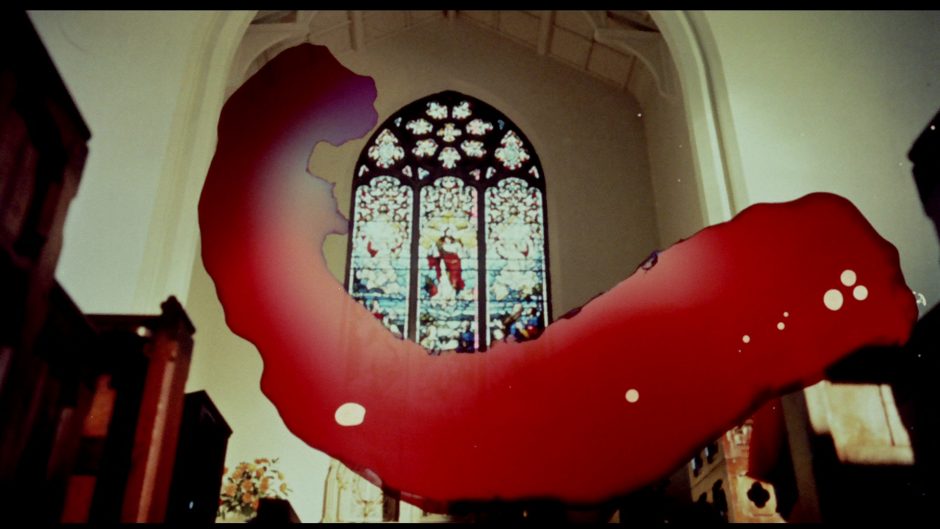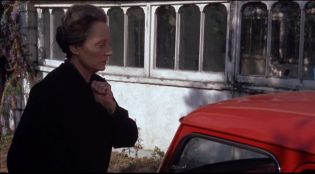by Paul Frith
An often over-looked offering from Hammer Film Productions, Fanatic (AKA Die! Die! My Darling: 1965) holds a unique position in the studio’s history as it represents the first, and only, of their 1960s cycle of psychological thrillers to be shot in colour. The film stars Tallulah Bankhead in her final screen role as Mrs Trefoil, a psychologically disturbed religious matriarch who keeps her dead son’s former fiancé Patricia (Stephanie Powers) prisoner as punishment for her sinful ways.

Aside from two minor non-horror entries in the Hammer canon[i], up until this point colour had been used exclusively in the production of a series of Gothic horrors and adventure films, which made full use of their lavishing period settings and vivid depictions of blood and gore.
Beginning with Taste of Fear in 1961, and inspired by the monochrome horror-thrillers Les Diaboliques (1955) and Psycho (1960), Hammer’s series of black-and-white ‘psycho-thrillers’ lacked ‘the grotesquery normally associated with Hammer Horror [and] employed the repertoire of the schauerromane instead, to full effect.’[ii]
The use of black-and-white in these films, and a lack of the ‘grotesquery’ which became a key selling point of their colour productions, relates to wider trends in British cinema during this period in which monochrome was most often associated with realistic contemporary settings[iii], while colour remained tied to fantasy and spectacle of the Gothic horrors:
As television itself adopted colour […] the aesthetic value of colour in the cinema began to change. As colour began to be used on television for news and current affairs programmes, the overwhelming association of colour with fantasy and spectacle began to be weakened: colour itself acquired instead the value of realism.[iv]
Though it may be true that colour was quickly becoming excepted as the standard in cinema (and later television) Hammer displayed an uncertainty when it came to the impact upon their run of thrillers, which had thus far been distinguished as an alternative to their visually explicit period-Gothics. These concerns are highlighted by director Silvio Narizzano in an interview conducted by fan publication The House of Hammer:
I remember saying to Tony Hinds [Hammer Producer] ‘I don’t like all this blood.’ And he said blood was not as horrible in colour. This was pre-Peckinpah and all the blood spurting craze. He said: ‘Now that we’re in colour, the audience seems to know it’s not real blood.’ Hammer seemed to feel it was a problem. All their horror and gore had been much more effective for the audience when they were in black-and-white. They were very concerned about it.[v]
While Hammer had been incorporating numerous shots of vivid blood and gore into their gothic horrors for years, these films were more closely linked to fantasy than the realism of the psychological thriller. Introducing these gruesome effects to Fanatic was therefore deemed to oppose to the naturalism established in their previous black-and-white productions.

Despite these concerns surrounding the use of blood in a more naturalistic setting, colour is also applied with great effect to emphasise Mrs Trefoils character and desire to rid herself, and the household, of a world of sinful pleasures. This is most prominently illustrated in the film’s repeated use of the colour red which is set in stark contrast to the drab surroundings of her home. We first witness this symbolism in the playful title sequence in which a bright-green cat (representing the envious Trefoil) chases a red mouse (the sinful Patricia) across the black screen. The envy from Trefoil represents both the love of her departed son, stolen from her by Patricia’s wicked sexual allure, and also a longing for Trefoil’s once sinful ways of her misspent youth as an actress.
The colour red also appears as several key moments later in the film, the first of which when Patricia enters the morning bible service dressed in a bright jumper, causing Trefoil to proclaim, ‘What are you wearing? The Devil’s colour! Go upstairs immediately and put on something proper!’ This impassioned response to Patricia’s attire is seen again later in a more aggressive manner when Trefoil orders her maid to destroy a bright red nightdress, discovered amongst Patricia’s belongings, with a pair of scissors.
In search of the missing Patricia, her new fiancé Alan later arrives at the house driving a red Mini Cooper, from which Trefoil recoils upon realising that she had almost let herself come into contact with the devilishly-coloured paintwork. (The appearance of the Mini Cooper also serves as a nod to the emerging ‘swinging’ culture – no doubt full of sinful excesses in Mrs Trefoil’s mind).

Whilst mulling over Patricia’s disappearance in a local pub, Alan recognises her broach being worn by the barmaid who has been having an affair with Trefoil’s servant Harry. In this scene, the barmaid wears a similarly vibrant red jumper as the one worn by Patricia earlier in the film, both indicating her adulterous relationship with Harry and the connection back to Patricia.
Although her home is devoid of colourful interiors, the sequence in which Trefoil murders Harry is elaborately bathed in multi-coloured light emanating from moonlight passing through a stained glass window. The scene takes place in the basement which we later discover is a shrine to both her dead son and former career as an actress and society girl. As he passes through the open door, Harry walks into cold lights of green and blue before it closes shut and reveals Trefoil stood waiting, shrouded in a fiery pink at the moment she shoots him dead.
Picking up the knife Harry had intended to use on her, Trefoil states ‘He who shedeth man’s blood, so shall his blood be shed’ as the screen is covered in red light before cutting to a shot of her walking up the stairs, her hands covered in blood.
Hammer made very few psychological horrors following the release of Fanatic, choosing to firmly position themselves in the realms of fantasy and horror for their remaining years (with the occasional foray into comedy) following a series of box-office disappointments . While the strong emphasis upon colour design, and concerns surrounding the plausibility of the gruesome effects, establish links to Hammer’s brand of fantasy horror, the use of colour in a contemporary psychological horror was certainly unique during this period. Released only a few years later, Rosemary’s Baby (1968) and The Exorcist (1973) are a haunting reminder of what could have been for the studio.
Footnotes
[i] Break in the Circle (1955) and Visa to Canton (AKA Passport to China: 1960).
[ii] Denis Meikle, A History of Horrors: The Rise and Fall of the House of Hammer. Lanham, MD: Scarecrow, 1996, p.145.
[iii] Peter Hutchings, Hammer and Beyond: The British Horror Film. Manchester: Manchester University Press, 1993, p.133.
[iv] Steve Neale, Cinema and Technology: Image, Sound, Colour. London: Macmillan, 1985, p.15.
[v] John Fleming, ‘Fanatic’, The House of Hammer 15, Dec 1977, p.22.












